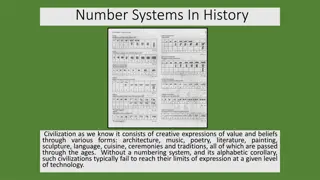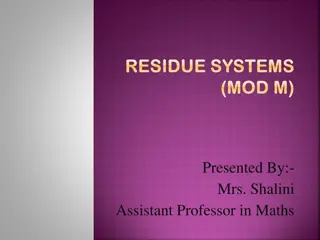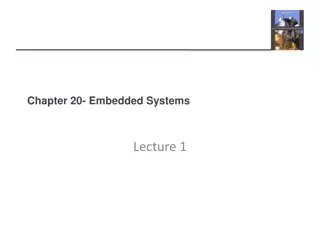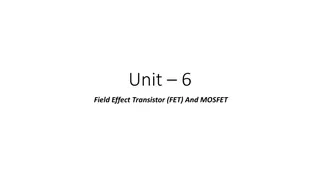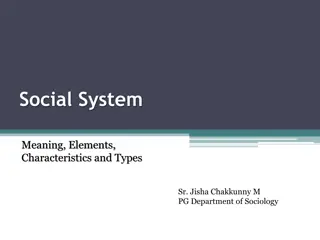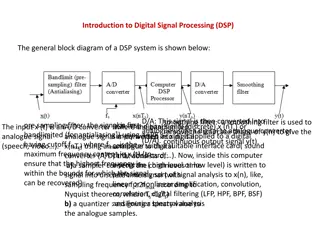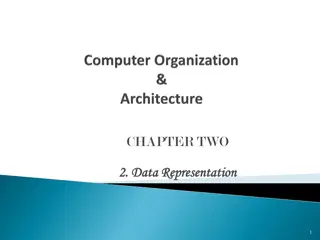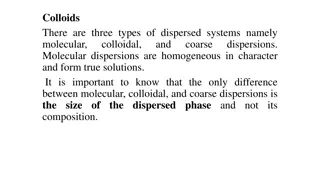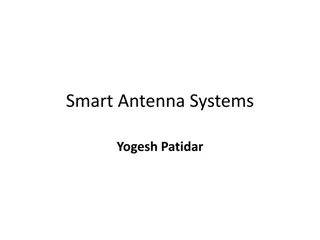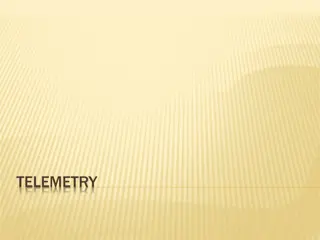Understanding Number Systems and Their Characteristics
Dive into the world of number systems, exploring non-positional and positional systems. Learn about the unique features of each system, including the use of symbols and digits, as well as how to convert numbers between different bases. Discover the Decimal Number System and its significance in everyday life through practical examples. Gain insights into fractional numbers in binary systems and shortcut methods for conversion. Expand your knowledge of arithmetic operations within different number systems.
Download Presentation

Please find below an Image/Link to download the presentation.
The content on the website is provided AS IS for your information and personal use only. It may not be sold, licensed, or shared on other websites without obtaining consent from the author. Download presentation by click this link. If you encounter any issues during the download, it is possible that the publisher has removed the file from their server.
E N D
Presentation Transcript
Number Systems Farah Sharmin Senior Lecturer Department of CSE Daffodil International University
Learning Objectives In this lecture you will learn about: Convert a number s base Another base to decimal base Decimal base to another base Some base to another base Non-positional number system Positional number system Shortcut methods for converting Binary to octal number Octal to binary number Binary to hexadecimal number Hexadecimal to binary number Decimal number system Binary number system Octal number system Hexadecimal number system Fractional numbers in binary number system
Number Systems Two types of number systems are: Non-positional number systems Positional number systems
Non-positional Number Systems Characteristics Use symbols such as I for 1, II for 2, III for 3, IIII for 4, IIIII for 5, etc. Each symbol represents the same value regardless of its position in the number The symbols are simply added to find out the value of a particular number Difficulty It is difficult to perform arithmetic with such a number system
Positional Number Systems Characteristics Use only a few symbols called digits These symbols represent different values depending on the position they occupy in the number The value of each digit is determined by The digit itself The position of the digit in the number The base of the number system (base = total number of digits in the number system) The maximum value of a single digit is always equal to one less than the value of the base
Decimal Number System Characteristics A positional number system Has 10 symbols or digits (0, 1, 2, 3, 4, 5, 6, 7, 8, 9). Hence, its base = 10 The maximum value of a single digit is 9 (one less than the value of the base) Each position of a digit represents a specific power of the base (10) We use this number system in our day-to-day life Example 258610 = (2 x 103) + (5 x 102) + (8 x 101) + (6 x 100) = 2000 + 500 + 80 + 6
Binary Number System Characteristics A positional number system Has only 2 symbols or digits (0 and 1). Hence its base = 2 The maximum value of a single digit is 1 (one less than the value of the base) Each position of a digit represents a specific power of the base (2) This number system is used in computers Example 101012 = (1 x 24) + (0 x 23) + (1 x 22) + (0 x 21) x (1 x 20) = 16 + 0 + 4 + 0 + 1 = 2110
Bit Bit stands for binary digit A bit in computer terminology means either a 0 or a 1 A binary number consisting of n bits is called an n-bit number
Representing Numbers in Different Number Systems In order to be specific about which number system we are referring to, it is a common practice to indicate the base as a subscript. Thus, we write: 101012 = 2110
Octal Number System Characteristics A positional number system Has total 8 symbols or digits (0, 1, 2, 3, 4, 5, 6, 7). Hence, its base = 8 The maximum value of a single digit is 7 (one less than the value of the base) Each position of a digit represents a specific power of the base (8) Since there are only 8 digits, 3 bits (23 = 8) are sufficient to represent any octal number in binary Example 20578 = (2 x 83) + (0 x 82) + (5 x 81) + (7 x 80) = 1024 + 0 + 40 + 7 = 107110
Hexadecimal Number System Characteristics A positional number system Has total 16 symbols or digits (0, 1, 2, 3, 4, 5, 6, 7, 8, 9, A, B, C, D, E, F). Hence its base = 16 The symbols A, B, C, D, E and F represent the decimal values 10, 11, 12, 13, 14 and 15 respectively The maximum value of a single digit is 15 (one less than the value of the base) Each position of a digit represents a specific power of the base (16) Since there are only 16 digits, 4 bits (24 = 16) are sufficient to represent any hexadecimal number in binary Example 1AF16 = (1 x 162) + (A x 161) + (F x 160) = 1 x 256 + 10 x 16 + 15 x 1 = 256 + 160 + 15 = 43110
Converting a Number of Another Base to a Decimal Number Method Step 1: Determine the column (positional) value of each digit Step 2: Multiply the obtained column values by the digits in the corresponding columns Step 3: Calculate the sum of these products
Converting a Number of Another Base to a Decimal Number Example
Converting a Decimal Number to a Number of Another Base Division-Remainder Method Step 1: Divide the decimal number to be converted by the value of the new base Step 2: Record the remainder from Step 1 as the rightmost digit (least significant digit) of the new base number Step 3: Divide the quotient of the previous divide by the new base Step 4: Record the remainder from Step 3 as the next digit (to the left) of the new base number Repeat Steps 3 and 4, recording remainders from right to left, until the quotient becomes zero in Step 3 Note that the last remainder thus obtained will be the most significant digit (MSD) of the new base number
Converting a Decimal Number to a Number of Another Base Example:
Converting a Number of Some Base to a Number of Another Base Method Step 1: Convert the original number to a decimal number (base 10) Step 2: Convert the decimal number so obtained to the new base number
Converting a Number of Some Base to a Number of Another Base Example:
Converting a Number of Some Base to a Number of Another Base
Shortcut Method for Converting a Binary Number to its Equivalent Octal Number Method Step 1: Divide the digits into groups of three starting from the right Step 2: Convert each group of three binary digits to one octal digit using the method of binary to decimal conversion
Shortcut Method for Converting a Binary Number to its Equivalent Octal Number Example:
Shortcut Method for Converting an Octal Number to Its Equivalent Binary Number Method Step 1: Convert each octal digit to a 3 digit binary number (the octal digits may be treated as decimal for this conversion) Step 2: Combine all the resulting binary groups (of 3 digits each) into a single binary number
Shortcut Method for Converting an Octal Number to Its Equivalent Binary Number Example:
Shortcut Method for Converting a Binary Number to its Equivalent Hexadecimal Number Method Step 1: Divide the binary digits into groups of four starting from the right Step 2: Combine each group of four binary digits to one hexadecimal digit
Shortcut Method for Converting a Binary Number to its Equivalent Hexadecimal Number Example:
Shortcut Method for Converting an Octal Number to Its Equivalent Binary Number Method Step 1: Convert each octal digit to a 3 digit binary number (the octal digits may be treated as decimal for this conversion) Step 2: Combine all the resulting binary groups (of 3 digits each) into a single binary number
Shortcut Method for Converting an Octal Number to Its Equivalent Binary Number Example:
Shortcut Method for Converting a Binary Number to its Equivalent Hexadecimal Number Example:
Shortcut Method for Converting a Hexadecimal Number to its Equivalent Binary Number Method Step 1: Convert the decimal equivalent of each hexadecimal digit to a 4 digit binary number Step 2: Combine all the resulting binary groups (of 4 digits each) in a single binary number
Shortcut Method for Converting a Hexadecimal Number to its Equivalent Binary Number Example: 2AB16 = ?2 Step 1: Convert each hexadecimal digit to a 4 digit binary number 216 = 210 = 00102 A16 = 1010 = 10102 B16 = 1110 = 10112 Step 2: Combine the binary groups 2AB16 = 0010 1010 1011 2 A B Hence, 2AB16 = 0010101010112
Fractional Numbers Fractional numbersare formed same way as decimal number system
Formation of Fractional Numbers in Binary Number System Example:
Formation of Fractional Numbers in Octal Number System Example:
Key Words/Phrases Base Least Significant Digit (LSD) Binary number system Memory dump Binary point Most Significant Digit (MSD) Bit Non-positional number Decimal number system system Division-Remainder technique Number system Fractional numbers Octal number system Hexadecimal number system Positional number system











